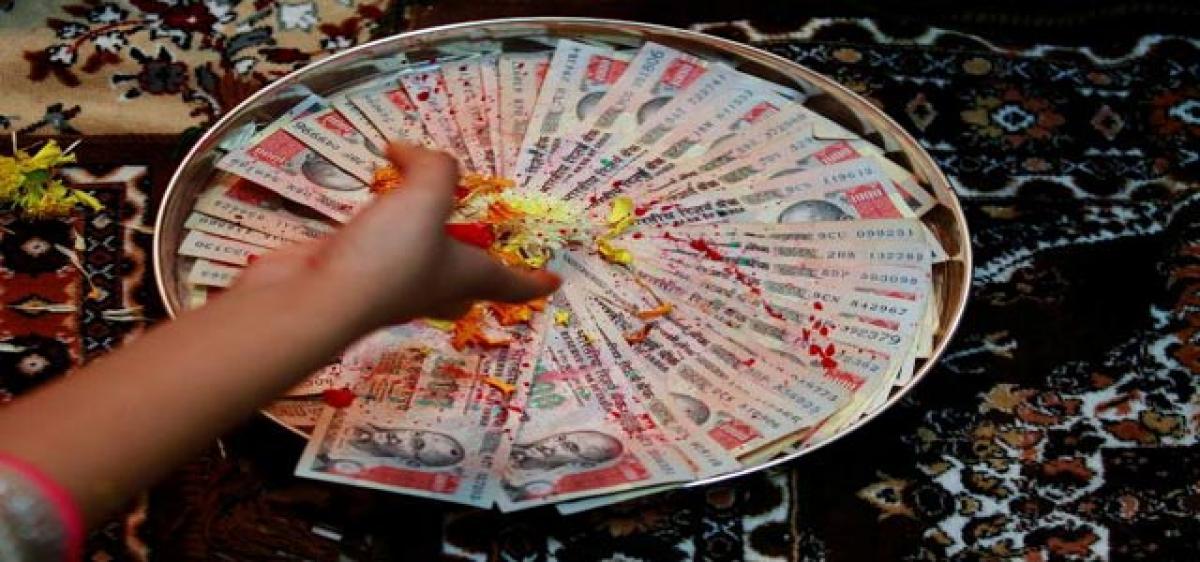Live
- ‘5 lakh votes’: Congress plans ‘biggest win’ for Priyanka in Wayanad
- 1st Test: Conway scores 91 as New Zealand end day two at 180/3, lead India by 134 runs
- India Mobile Congress 2024 - Day 3 - Industry calls for global collaboration for 6G and India taking a leading role
- NHRC orders Rs 4.5 cr relief for 89 judicial custody death victims in 2024-25
- CBI books Pune-based official of RoC for Rs 3 lakh bribe
- Japan reports first bird flu outbreak of the season
- IND vs NZ: New Zealand end day two at 180/3 after bundling India out for just 46
- ‘Tampered video’, says MP's Cong MLA after clip goes viral ahead of bypolls
- Referees' chief Webb confident of improved VAR standards in ongoing PL season
- IDF says killed Hezbollah battalion commander in Lebanon
Just In

The New Year will be shaped by the way the present one is ending, with people struggling with cash shortages as a result of the government’s decision in November to cancel nearly 90% of the country’s paper money in a stroke.
Cash flow after note ban
The New Year will be shaped by the way the present one is ending, with people struggling with cash shortages as a result of the government’s decision in November to cancel nearly 90% of the country’s paper money in a stroke. The economic toll has already been significant, and officials have given no clear signs on when withdrawal limits at banks and ATMs will be lifted.
Whether all the pain was worth it rests on the government’s ability to nab tax evaders, corrupt officials and shady businessmen who have been forced to come forward with their stockpiled loot. But India’s Income-Tax department is overstretched even in good times; tax disputes can languish for years in court. Much is also to be seen about the move’s political cost to its principal architect and champion, Mr Modi. Raymond Zhong.
Progress of GST
The implementation of the Goods and Services Tax will be the mostwatched piece of economic policymaking in 2017. The new nationwide levy is expected to boost growth and ease of doing business. Modi’s government must strike a deal with state governments over how the tax will be administered. Officials had hoped to do so by April 1, the start of the next financial year, but analysts now expect that deadline to be missed by at least a couple of months. The proposed tax aims to consolidate a maze of overlapping state and federal levies.
The price of gold
India’s love affair with gold looks to be souring even as Modi’s war on cash and a stronger dollar pushed prices of the yellow metal down. Gold performed strongly through most of 2016, up until the US elections, when the dollar strengthened following Trump’s surprise victory. The price of the precious metal tends to move in the opposite direction to the US currency. Yet cash shortages since November have made it difficult for many people to buy gold, even at more-attractive prices. Purchases should bounce back, analysts say, as cash flows back into the economy. But a lengthier spell of depressed demand from the usually gold-hungry nation could hit global prices.
UP elections
No political event in 2017 is more widely anticipated than elections in Uttar Pradesh, the largest state, where 200 million people live and where political destinies are made and broken. The result of the vote–likely to take place in the spring–will set the tone and direction of Indian politics for years to come. A victory for the BJP would be seen as a big thumbs up for the radical policy he staked his political capital on—the abrupt cancellation of high-denomination currency notes—and prepare the groundwork for his re-election bid in 2019. It would also break one of the defining patterns of politics in recent decades by shifting power away from regional parties, two of which have held sway in Uttar Pradesh for years. A defeat for Modi, on the other hand, particularly in the so-called Hindi heartland that should count as a stronghold, would severely mar his image as India’s most popular leader in decades and provide a major opening for opposition parties.
Battle for E Commerce
superiority The year ahead could be crunch time as e-commerce startups battle for dominance in a huge but challenging market. Analysts say homegrown shopping site Flipkart Internet Pvt, long the leading player, has started to lose market share to Amazon.com Inc, whose famously competitive founder, Jeff Bezos, is investing some $5 billion in the country.
Amazon has been expanding its network of warehouses and adding sellers and products to its platform, although Flipkart has operated in India for longer and enjoys significant brand awareness. Both are splashing out on advertising campaigns and racing to make deliveries more quickly, though factors like low internet penetration and credit card usage, along with poor infrastructure, make India a challenging market. Still, it is one worth fighting for, given India’s population of more than 1.2 billion most of whom have yet to get online. (Courtesy: The Wall Street Journal)

© 2024 Hyderabad Media House Limited/The Hans India. All rights reserved. Powered by hocalwire.com







